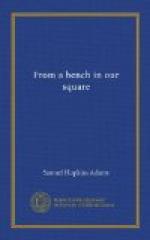“Why did I bring thee, Sweet
Into a world of sin?—
Into a world of wonder and doubt
With sorrows and snares for the little
white feet—
Into a world whence the going out
Is as dark as the coming in!”
Old lips readily lend themselves to memory; I suppose I must have repeated the final lines aloud, for the pink man said, wearily but politely:
“Very pretty. Something more in the local line?”
“Hardly.” I smiled. Between Bartholomew Storr’s elegies and William Young’s “Wish-makers’ Town” stretches an infinite chasm.
“What’s this—now—God’s Acre the kid was talking about?” was his next question.
“An old local graveyard.”
“Anything interesting?” he asked carelessly.
“If you’re interested in that sort of thing. Are you an antiquary?”
“Sure!” he replied with such offhand promptitude that I was certain the answer would have been the same had I asked him if he was a dromedary.
“Come along, then. I’ll take you there.”
To reach that little green space of peace amidst our turmoil of the crowded, encroaching slums, we must pass the Bonnie Lassie’s house, where her tiny figurines, touched with the fire of her love and her genius, which are perhaps one and the same, stand ever on guard, looking out over Our Square from her windows. Judging by his appearance and conversation, I should have supposed my companion to be as little concerned with art as with, let us say, poetry or local antiquities. But he stopped dead in his tracks, before the first window. Fingers that were like steel claws buried themselves in my arm. The other hand pointed.
“What’s that?” he muttered fiercely.
“That,” to which he was pointing, was a pictorial bronze, the figure of a girl, upright in a cockleshell boat, made of a rose-petal, her arms outspread to the breeze that was bearing her out across sunlit ripples. Beneath was the legend: “Far Ports.” The face, eager, laughing, passionate, adventurous, was the face of Minnie Munn. Therein the Bonnie Lassie had been prophetess as well as poet and sculptress, for she had finished the bronze before Minnie left us.
“That,” I answered the strong, pink man, trying to shake loose his grip, “is a sculpture by Cecily Willard, otherwise Mrs. Cyrus Staten.”
“What’ll she take for it?”
“It can’t be bought.” I spoke with authority, for the figurines that the Bonnie Lassie sets in her window are not for sale, but for us of Our Square, who love them.




